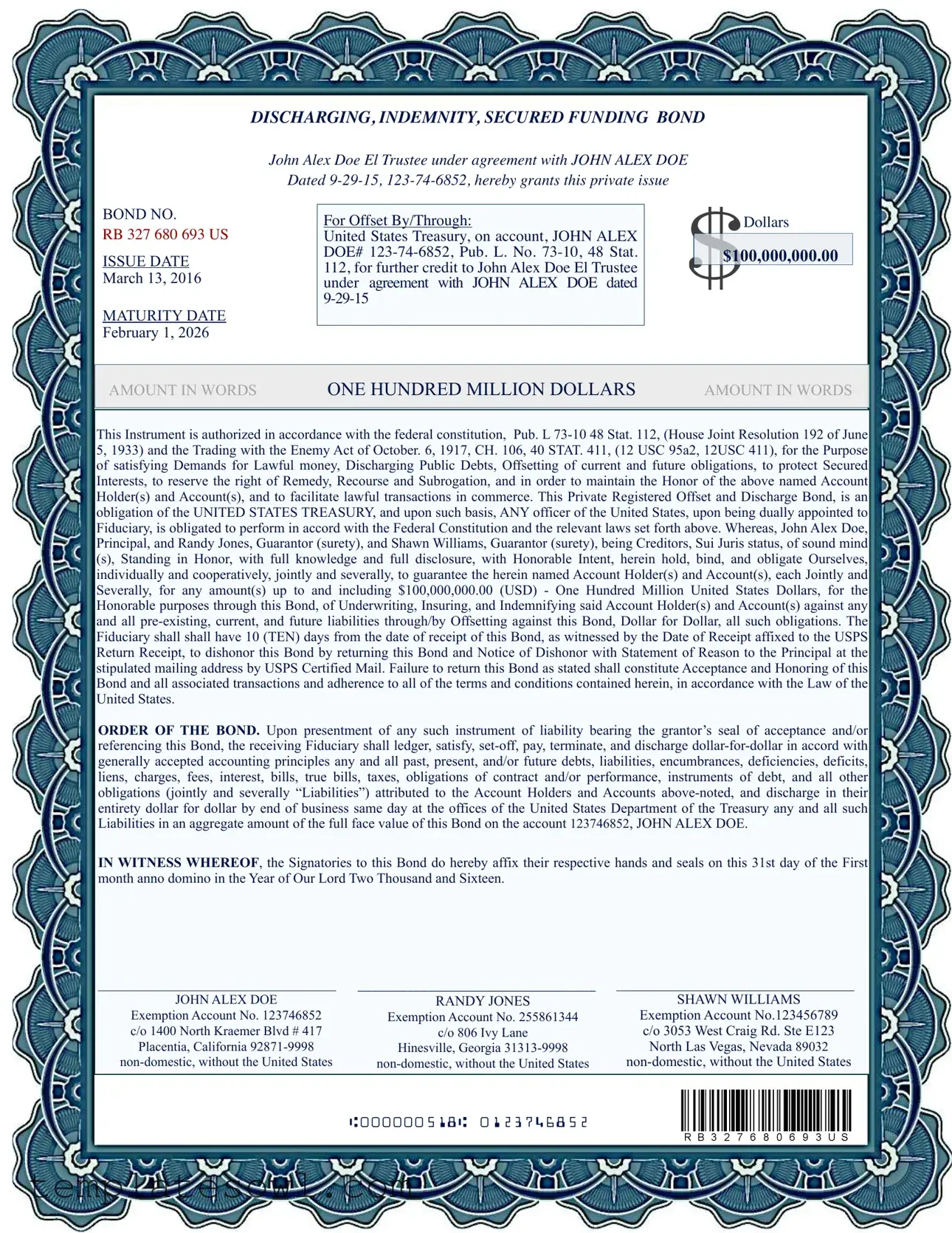AMOUNT IN WORDS |
ONE HUNDRED MILLION DOLLARS |
AMOUNT IN WORDS |
|
|
|
This Instrument is authorized in accordance with the federal constitution, Pub. L 73-10 48 Stat. 112, (House Joint Resolution 192 of June 5, 1933) and the Trading with the Enemy Act of October. 6, 1917, CH. 106, 40 STAT. 411, (12 USC 95a2, 12USC 411), for the Purpose of satisfying Demands for Lawful money, Discharging Public Debts, Offsetting of current and future obligations, to protect Secured Interests, to reserve the right of Remedy, Recourse and Subrogation, and in order to maintain the Honor of the above named Account Holder(s) and Account(s), and to facilitate lawful transactions in commerce. This Private Registered Offset and Discharge Bond, is an obligation of the UNITED STATES TREASURY, and upon such basis, ANY officer of the United States, upon being dually appointed to Fiduciary, is obligated to perform in accord with the Federal Constitution and the relevant laws set forth above. Whereas, John Alex Doe, Principal, and Randy Jones, Guarantor (surety), and Shawn Williams, Guarantor (surety), being Creditors, Sui Juris status, of sound mind (s), Standing in Honor, with full knowledge and full disclosure, with Honorable Intent, herein hold, bind, and obligate Ourselves, individually and cooperatively, jointly and severally, to guarantee the herein named Account Holder(s) and Account(s), each Jointly and Severally, for any amount(s) up to and including $100,000,000.00 (USD) - One Hundred Million United States Dollars, for the Honorable purposes through this Bond, of Underwriting, Insuring, and Indemnifying said Account Holder(s) and Account(s) against any and all pre-existing, current, and future liabilities through/by Offsetting against this Bond, Dollar for Dollar, all such obligations. The Fiduciary shall shall have 10 (TEN) days from the date of receipt of this Bond, as witnessed by the Date of Receipt affixed to the USPS Return Receipt, to dishonor this Bond by returning this Bond and Notice of Dishonor with Statement of Reason to the Principal at the stipulated mailing address by USPS Certified Mail. Failure to return this Bond as stated shall constitute Acceptance and Honoring of this Bond and all associated transactions and adherence to all of the terms and conditions contained herein, in accordance with the Law of the United States.
ORDER OF THE BOND. Upon presentment of any such instrument of liability bearing the grantor’s seal of acceptance and/or referencing this Bond, the receiving Fiduciary shall ledger, satisfy, set-off, pay, terminate, and discharge dollar-for-dollar in accord with generally accepted accounting principles any and all past, present, and/or future debts, liabilities, encumbrances, deficiencies, deficits, liens, charges, fees, interest, bills, true bills, taxes, obligations of contract and/or performance, instruments of debt, and all other obligations (jointly and severally “Liabilities”) attributed to the Account Holders and Accounts above-noted, and discharge in their entirety dollar for dollar by end of business same day at the offices of the United States Department of the Treasury any and all such Liabilities in an aggregate amount of the full face value of this Bond on the account 123746852, JOHN ALEX DOE.
IN WITNESS WHEREOF, the Signatories to this Bond do hereby affix their respective hands and seals on this 31st day of the First month anno domino in the Year of Our Lord Two Thousand and Sixteen.
__________________________________ |
__________________________________ |
__________________________________ |
JOHN ALEX DOE |
RANDY JONES |
SHAWN WILLIAMS |
Exemption Account No. 123746852 |
Exemption Account No. 255861344 |
Exemption Account No.123456789 |
c/o 1400 North Kraemer Blvd # 417 |
c/o 806 Ivy Lane |
c/o 3053 West Craig Rd. Ste E123 |
Placentia, California 92871-9998 |
Hinesville, Georgia 31313-9998 |
North Las Vegas, Nevada 89032 |
non-domestic, without the United States |
non-domestic, without the United States |
non-domestic, without the United States |


